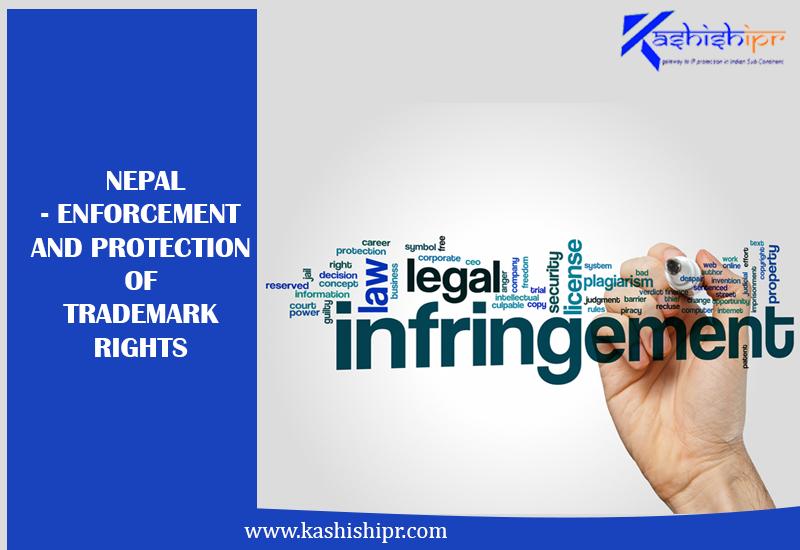Nepal Enforcement And Protection Of Trademark Rights
In Nepal, the mechanism of enforcement and protection of a trademark is governed by the Patent, Design and Trademark Act (PDTA), 1965 (2022). Under Section 18 of this act, a trademark registered by any person is valid for 7 years from the date of application.
Department of Industries (DOI), within the Ministry of Industries, administers both local and foreign trademark-related issues.
The DOI performs two functions: administrative and judicial function for the enforcement and protection of trademark rights:
- Administrative Functions:
- Registration and Renewal of trademark
- Trademark Assignment and licensing, etc.
- Changes of recordal of trademark (Name and address)
- Quasi-Judicial Functions:
- Trademark pre-opposition
- Trademark Revocation
- Action against unauthorized use, infringement and imitation trademark.
Nepal has signed various international treaties for trademark protection and enforcement, which are as follows:
- The Paris Convention For Protection of Industrial Property, 1883, (also called as Paris convention), on June 22,
- Conventions Establishing the World Intellectual Property Organization, 1979, on February 4, 1997.
- Agreement on Trade-Related Aspects of Intellectual Property Rights, 1995, on April 23, 2004.
PROTECTION BASED ON REGISTRATION
Under Section 16 of PDTA, a person can secure a trademark title only through registering with the DOI.
WELL-KNOWN MARKS PROTECTION
Under the PDTA, there is no specific provision pertaining to the well-known trademark protection on the basis of use. However, according to Section 18(1) and (3) of the PDTA, the DOI can cancel or refuse any trademark application or already registered trademark in such cases: a) damaging any institution or an individual’s reputation, or b) harming the other’s trademark reputation.
INFRINGEMENT
A trademark right is infringed if a person uses or imitates similar or confusing goods, which is already registered. The person can take infringement action only for the registered trademark by proving the identical or similar trademark which is used by the defendant without any prior permission or authority. The owner of the registered trademark can seek legal action by filing the trademark infringement action complaint. However, there is no limitation period for filing an application for infringement.
Criminal, civil and administrative actions can be taken in case of trademark infringement. Under the Civil Right Act 1955, a person can file an injunction with the High Court. For administrative action, a complaint can be filed on infringement with the Department of Industry.
Injunctions
Rules and Procedure for governing the issuance of the injunction for preventing imminent or further infringement:
An injunction is filed under the Civil Right Act 1955 and other concerning High Court regulations. A raid is conducted on the premises where the trademark infringement has allegedly taken place.
REMEDIES
Civil Action
The trademark owner is entitled to an injunction if he justifies his claim to the authorities that its trademark has been infringed. The person can claim for damages by submitting the evidence regarding the actual damage suffered by him. The infringing goods/ label/advt. the material can also be seized for destruction.
Criminal Action
Any goods/ labels/advertising and printing material, etc. which are violating someone’s trademark right, can be seized. That person can be fined up to NRS 1000000, for the offense. Raids are conducted only when criminal action is taken, and while taking civil action, raids cannot be conducted.
CUSTOM ENFORCEMENT
In Nepal, the Ministry of Finance, under the Customs Act 2007 regulates all the trading activities. Under Section 68 (1), if a person imports or exports goods by violating the IP rights of any party, then the concerned party can file an application, along with evidence to the customer officer for the withholding the import or export.
If an application is submitted under Section 68 (1), the customs officer can halt import or export of such goods, and can further request to the concerned authority for taking necessary action, under section 68 (2).
The authority will take relevant action as per the prevailing law. After that, under section 68 (3) information will be given to the customs office.
If it’s found that goods are liable for forfeiting, the customs officer under Section 68 (3), will hand over the hand over those goods and services to the concerned body.
Defenses available to the infringers:
In case of infringement of trademark rights, the defendant can plead for the following defenses:
- The doctrine of estoppels;
- The doctrine of laches;
- Can prove the dissimilarity between the trademark;
- Can also show that the feature of its goods is completely different from that of the plaintiff;
- Can argue that the customer base is entirely different from the plaintiff;
Under Section 27 of the Patent, Design, and the Trademark Act (2022/ 1965), an appeal can be made within the 35 days from the issuance of infringement decision. For more visit: https://www.kashishipr.com/

